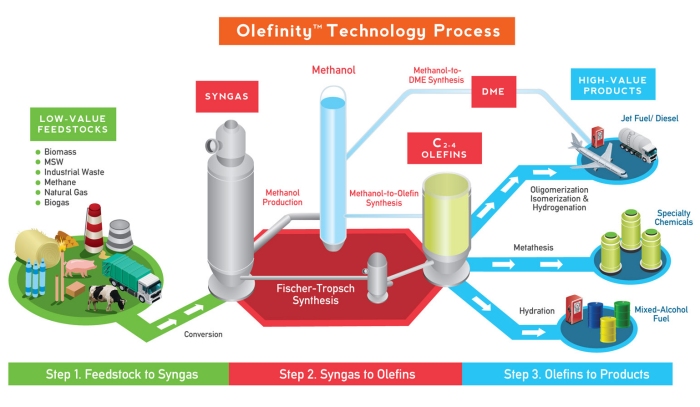Conversion Process Details
Maverick Synfuels > Technology > Conversion Process Details
Syngas Production: Maverick is working with multiple technology partners for equipment to convert feedstock to syngas. Syngas can be produced directly from methane-rich gas streams using steam reformer technology to produce a hydrogen rich syngas. Solid feedstocks such as biomass, whether purpose-grown or waste biomass, and landfill/industrial waste, can be converted to syngas using gasification technology. The initial hydrogen content is low enough to favor direct olefin production, and the hydrogen content can be increased (with some loss of overall yield) to favor methanol production. The choice of approach to producing syngas will depend on a number of factors, including the available feedstock, the local markets for either a mixture of olefins or for methanol, and/or the size of the feedstock supply.
Olefin Production: Olefins, 2 to 5 carbon chains with one double bond, are produced from methanol using methanol-to-olefin (MTO) chemistry or using Fischer-Tropsch chemistry and Maverick’s proprietary catalyst. Using the MTO process, the syngas is converted to methanol using one of several commercially available catalysts. The methanol itself can be transported to a central hub or it can be sold directly into the market place. After the methanol is transported to a central hub, it is converted to olefins. Typically, the MTO process yields an olefin stream that is rich in C3 olefins.
The Fischer-Tropsch process produces various co-products such as higher molecular weight liquid and wax hydrocarbons. The olefin rich gas stream can be converted directly or it can be transported to a central facility for further processing.
Olefin Conversion: At a central hub, we can convert either of the transportable intermediates, methanol or olefins, to higher-value products.
Diesel/Jet Fuel: Diesel or jet fuel is produced by a process called olefin oligomerization. The olefins (whether initially produced directly or produced from methanol) are joined together. The specific process employed will dictate the final product and the amount of product purification required. One example includes Clariant’s COD (conversion of olefins to distillates).
Mixed Alcohol: U.S. auto manufacturers have developed engines that work with fuels that have relatively high alcohol concentrations. As described elsewhere, Maverick either directly produces a mixture of olefins, or indirectly produces these olefins through a methanol intermediate. A process known as olefin hydration adds water to the olefins to form a mixture of alcohols. This mixture has approximately 80-85% of the energy density of gasoline and is comprised of a mixture of ethanol, propanol, and butanol.
Propylene: Both olefin production processes produce some ethylene and butylene, C2 and C4 olefins. These olefins can be converted to propylene, a C3 olefin, using a process called olefin metathesis. In olefin metathesis the C2 and C4 olefin are first combined to form a C6 molecule that is subsequently broke in half to form 2 propylene molecules.
